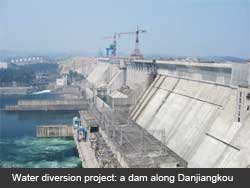

From Print edition, News, page 3, issue no. 419, May 18, 2009
Translated by Zhang Junting
Original article: [Chinese]
After some seven years in progress, China's South-to-North Water Transfer Project has burst its planned budget by tens of billions of yuan and run into delay.
The dealy will certainly add pressure to water scarcity in the country's parched northern region, where price hike may be inevitable as a result.
The Economic Observer learned that though the project kicked start in 2002, its feasibility study was only concluded late last year, revealing the need for additional investment and rescheduling its completion date five years later than originally planned.
An official from the project's construction committee told the EO that it would be delayed due to three reasons.
First, part of the project's engineering aspects needed fine tuning; second, relocation of affected residents and land acquisition required more time; and third, substantial additional investment needed approval from the central government.
Changes in Time Line The project aims to funnel some 45-billion cubic meters of water each year from China's longest river, Yangtze, northward via three diversion routes when completed.
The project aims to funnel some 45-billion cubic meters of water each year from China's longest river, Yangtze, northward via three diversion routes when completed.
The middle, eastern, and western routes measure 1,300 kilometers in length in total.
The EO learned that under the newly rescheduled plan, the eastern route would be completed by 2013 as oppose to 2007 as originally planned; this route would feed water to Jiangsu and Shandong provinces.
Meanwhile, the middle route - mainly to quench the thirst of Beijing - would begin water transfer by 2014 instead of 2010. In addition, the western route would start construction in 2020 and be completed by 2050.
As the project has far reaching impacts, the delay has triggered much speculations. Some even suspected that the Chinese government might defer the ambitious project, for it could be more expensive than drawing water from sea desalinization.
The delay also means bad news for Beijing, which will face increasing pressure from severe water shortage in the coming years.
Beijing Water Authority director-general Chengjing said preparations were underway to raise prices for water to reflect its scarcity and to push for conservation.
Since 2001, the city has upped prices for water four times, with the composite price inching up from 3.01 yuan to the present 5.40 yuan.
Rising Investment
On the project exceeding initial budget, an official justified that it was due to "rising prices of goods and changes in the investment structure".
The official declined to disclose the exact figure, but said the sum would be enormous, so much so that the National Development and Reform Committee, the country's top economic planner, would need to seek approval from the central government.
The EO learned from other sources that the additional investment might come up to some 50 billion yuan, pushing the total investment for the middle and eastern routes up to 254.6 billion yuan.
Some personnel from the water resources and management agencies complained that the rising cost could have been avoided.
"If only the relevant authorities had attended to the feasibility study in a timely manner, and accelerated the construction process, the investment figure would not have increased so substantially. As a result, the original plan has to be revamped," a source told the EO.
According to the latest figures released by the officials, by the end of April, the government had invested 53.87 billion yuan for the construction of the middle and eastern routes.
Of the amount, the central government contributed 15.42 billion yuan, while 10.65 billion yuan was raised through treasury bonds, and 7.99 billion yuan from local government funds; the remainder 19.81 billion yuan came from loans.
As the ambitious project proved to be costly, some quarters suggested the Chinese government to play by market principles, and open up the project to private capital participation.
However, a consultant from the project's experts advisory committee said such approach would be unlikely.
He said: "water is unlike any other commercial product, the government needs to exert control over its pricing when necessary to secure the people's livelihood. As a result, it's impossible to guarantee that investors could get the desired returns."
The EO learned that Chinese policy makers did consider adopting some forms of market-oriented approaches. For instance, the Ministry of Water Resources had converted the South-to-North Water Transfer Project Middle Route Management Bureau into a company.
One water industry player told the EO that the above move was paving the way for corporate management of water resources, similar to the role played by the State Grid, the state-owned enterprise that operates power supply in China.

